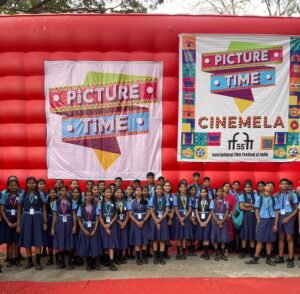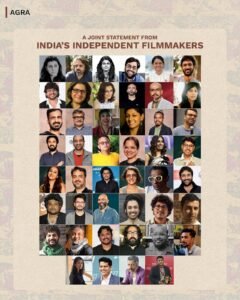GSFF 2025: a Call for a fairer, border vision

– Vishal Pai Cacode
As the Goa State Film Festival 2025 approaches, it is evident that the regulatory framework governing the event is in urgent need of a comprehensive overhaul. Shockingly, the Goa State Film Festival Regulations, 2014, formulated over a decade ago, have been carried forward without revision and made applicable to the 2025 edition. A close reading of these regulations reveals multiple inconsistencies, outdated clauses, and policy gaps that could significantly compromise the credibility, fairness, and inclusivity of the festival. Worse still, applying such an obsolete framework to a major state-sponsored cultural event in 2025 could expose the festival to legal scrutiny and even lead to a potential judicial challenge, especially given the contradictions and procedural lapses embedded in the current document.
As the Goa State Film Festival 2025 approaches, it is evident that the regulatory framework governing the event is in urgent need of a comprehensive overhaul. Shockingly, the Goa State Film Festival Regulations, 2014, formulated over a decade ago, have been carried forward without revision and made applicable to the 2025 edition. A close reading of these regulations reveals multiple inconsistencies, outdated clauses, and policy gaps that could significantly compromise the credibility, fairness, and inclusivity of the festival. Worse still, applying such an obsolete framework to a major state-sponsored cultural event in 2025 could expose the festival to legal scrutiny and even lead to a potential judicial challenge, especially given the contradictions and procedural lapses embedded in the current document.
One of the core issues I’ve identified is the lack of balance in the composition of the Entertainment Society of Goa (ESG), the agency responsible for organizing the festival. While ESG is expected to manage a major cultural and creative platform, its current structure appears to favour administrative functionaries without adequate representation from individuals with strong backgrounds in cinema, arts, culture, and event planning. What we need is a body composed of professionals who are not only well-versed in administrative frameworks but who also understand the nuances, challenges, and rhythms of the artistic community. Without this blend, policies are bound to remain disconnected from ground realities.
Another concern is the continued reliance on the 2014 Notification, which forms the basis of the festival’s rules and regulations. Drafted more than ten years ago, this document is no longer fit for purpose in the present context. Several clauses are outdated, irrelevant, or internally contradictory. For example, Clause 4 (a), (b), and (c), which defines the eligibility based on the duration of Feature and Non-Feature films, clashes directly with Clause 9.3 (iv) and (v). This creates unnecessary confusion for filmmakers and opens the door to selective enforcement or misinterpretation.
It is shocking to note that Clause 9.3 (iii) still references the 5th, 6th, and 7th editions of the festival—an oversight that underscores just how little the document has been revised to reflect present-day realities. Equally concerning is the clause that allows only 15% Goan representation among screen artists and technicians. If the objective of the festival is to promote local talent, the current formula is counterproductive. The ratio must be reversed to 85% Goan and 15% non-Goan to truly empower local filmmakers and professionals.
A deeper dive into the award structure reveals further flaws. Several vital categories such as Best Director, Best Actor, and others in the Non-Feature Film section are completely missing. This creates an impression that the non-feature format is less valued, which is both inaccurate and unfair. There must be uniformity in award categories across both formats to ensure the festival treats all filmmakers with equal respect and seriousness.
One of the most problematic requirements is the mandatory submission of a Censor Board certificate, even for Non-Feature films. This places an undue burden on independent and low-budget filmmakers, many of whom work without institutional backing. In several other states, exemptions or alternative certification routes are allowed to encourage regional voices. Goa should adopt a similar progressive approach instead of creating additional hurdles.
The deadline for submission of Domicile Certificates is also unnecessarily rigid. It would be more reasonable and inclusive to extend the deadline up to the start of the festival, ensuring that eligible participants are not disqualified simply due to procedural delays.
Most importantly, the regulations clearly state that the State Film Festival should be held once every two years, covering films produced during the two preceding calendar years. This biennial model ensures timely recognition and healthy competition. Unfortunately, this has not been followed. Three editions of the festival are now being clubbed together, which not only dilutes the competitive spirit but also reflects poorly on administrative consistency and planning.
All these concerns point to a larger systemic problem. Why are festival rules being framed and enforced without consulting the very community the festival is meant to serve? The current policymaking process lacks transparency, inclusivity, and cultural sensitivity. What Goa needs is not just a revision of a few clauses but a complete rethink of how the festival is administered, from rule-making to representation.
In addition, ESG must step beyond its role as a mere organiser and take proactive steps to empower Goan filmmakers on the ground. This includes effective implementation of the Film Finance Scheme and, most critically, providing access to basic production infrastructure such as shooting screens, reflectors, lighting equipment, cranes, and vanity vans. These resources are essential to enable filmmakers to produce more films of higher quality. Encouraging greater participation through logistical support will naturally raise the level of competition and drive up standards, ensuring that the festival becomes a true showcase of Goan talent.
The Goa State Film Festival 2025 can still be a celebration of Goan creativity, but only if ESG and the state government recognise that the 2014 regulations no longer reflect the current landscape. Continuing to operate under these outdated rules not only jeopardises the integrity of the festival but also risks being struck down if subjected to legal challenge.
It’s time to bring stakeholders to the table, update policies to meet today’s needs, and ensure that the festival serves as a genuine platform for Goan cinema—not a bureaucratic formality stuck in the past.
Former Member of Entertainment Society of Goa and Goa State Cultural Development Committee







